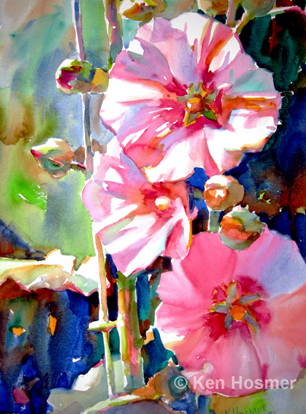
5 Helpful Tips for Painting Flowers
It's springtime! Time to enjoy colorful flowers coming into bloom all around us. This grand moment reminds me of the renewal of life and refreshes my excitement for creating new paintings.
Enjoy the following short video, sharing some of my favorite floral watercolors, and see helpful tips for painting flowers.
Featured Image:
'Hollyhock Symphony'—watercolor painting by Ken Hosmer
Floral Watercolors by Ken Hosmer
Full screen box lower right.
Five Helpful Tips on Painting Flowers
Zoom In
One thing I enjoy most about flowers is the delicate nuances created by light and shadow. So I zoom in, allowing the blossoms to fill my entire sheet of watercolor paper. This allows me to better emphasize each delicate flower form.
Pinpoint the Light Direction
Squint your eyes to see where the flowers are catching light and which sections are in shadow. Then try to determine which direction the light is coming from. If working from photographs, look at stems for clues on whether the light is coming from left or right. A strong light source will make the painting more convincing. For example, if you determine that the light is coming from upper-left, then you might exaggerate the light on tops and left sides of all the flowers, while adding more shadow on the right sides.
Paint Shadows
Forget you are painting flower petals—instead focus on painting the shadow shapes. Three things create the illusion of shadow: shape, edge and value. Look at the overall shape of the shadow piece. Notice that a smoothly curving petal creates a soft-edged form shadow, while a cast shadow has a slightly harder edge. Note that shadow edges want to appear softer than the actual edges of petals. Generally where light hits the flower it is light-value and often left as white paper; where the flower falls into shadow, it is generally mid-value.
Play With Color
To make the painting more exciting, it is better to have a variety of hues rather than one constant pigment color in each flower. For example if I am painting a red rose, I might use the entire analogous range of reds from red-orange (pyrrol orange) to red-violet (quinacridone red). Also, don't forget to mix some of the background color into the flower shadows, as this will visually relate the flower to the background.
Capture the Center
The center of a flower is like the eyes in a portrait. The viewer's attention focuses on the center. So pay extra attention to the texture and structure of the center and stamens. Then try to capture this essence in your painting.
Note that in each watercolor workshop, I generally complete one flower painting demonstration which illustrates the above helpful tips.
Other Resources:
Secrets of Flower Painting Video
